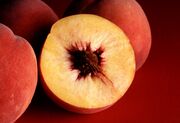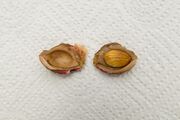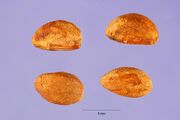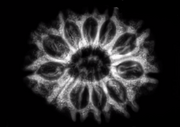Biology:Pyrena
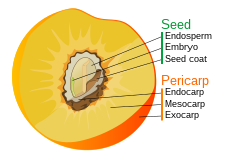
A pyrena or pyrene (commonly called a "pit" or "stone") is the fruitstone within a drupe or drupelet produced by the ossification of the endocarp or lining of the fruit.[1] It consists of a hard endocarp tissue surrounding one or more seeds (also called the "kernel").[2][3] The hardened endocarp which constitutes the pyrene provides a protective physical barrier around the seed, shielding it from pathogens and herbivory.[4]
While many drupes are monopyrenous, containing only one pyrene, pome-type fruit with a hard, stony (rather than leathery) endocarp are typically polypyrenous drupes, containing multiple pyrenes.[5]
Development
The hardening of the endocarp of a developing drupe occurs via secondary cell wall formation and lignification.[4] The biopolymer lignin, also found in wood, provides a structure within secondary cell walls which supports the polymerisation of cellulose and hemicellulose; together these polymers provide the endocarp with tensile strength and stiffness.[4] Further hardening occurs during the biomineralisation of the endocarp. The biomineralisation of pyrenes during the life of the plant can aid the preservation of fruit remains in archaeological findings.[6][7]
Gallery
-
Cross-section of a peach, a monopyrenous drupe, cut to reveal the pyrene inside
-
Pyrene of a peach dissected to reveal a single seed inside
-
Pyrenes extracted from a single fruit of Crataegus punctata, a polypyrenous drupe
-
X-ray of a pyrene of Elaeocarpus ganitrus revealing 10 seed-bearing locules inside; the number of locules in E. ganitrus pyrenes is variable between individual fruits
See also
References
Bibliography
- Allué, Ethel; Cáceres, Isabel; Expósito, Isabel; Canals, Antoni; Rodríguez, Anna; Rosell, Jordi; Bermúdez de Castro, José María; Carbonell, Eudald (2015). "Celtis remains from the Lower Pleistocene of Gran Dolina, Atapuerca (Burgos, Spain)". Journal of Archaeological Science 53: 570–577. doi:10.1016/j.jas.2014.11.016.
- Beentje, H.; Williamson, J. (2010). The Kew Plant Glossary: an Illustrated Dictionary of Plant Terms. Royal Botanic Gardens, Kew: Kew Publishing.
- Dardick, Chris; Callahan, Ann M. (2014). "Evolution of the fruit endocarp: molecular mechanisms underlying adaptations in seed protection and dispersal strategies". Frontiers in Plant Science 5: 284. doi:10.3389/fpls.2014.00284. ISSN 1664-462X. PMID 25009543.
- Eckel, P.M. (2011). "A Grammatical Dictionary of Botanical Latin". Missouri Botanical Garden. http://www.mobot.org/mobot/latindict/keyDetail.aspx?keyWord=stone.
- Hickey, M.; King, C. (2001). The Cambridge Illustrated Glossary of Botanical Terms. Cambridge University Press.
- Messager, Erwan; Badou, Aïcha; Fröhlich, François; Deniaux, Brigitte; Lordkipanidze, David; Voinchet, Pierre (2010). "Fruit and seed biomineralization and its effect on preservation". Archaeological and Anthropological Sciences 2 (1): 25–34. doi:10.1007/s12520-010-0024-1. https://hal.archives-ouvertes.fr/hal-02949710/file/2010%20graine%20biomin.pdf.
- Potter, D.; Eriksson, T.; Evans, R.C.; Oh, S.; Smedmark, J.E.E.; Morgan, D.R.; Kerr, M.; Robertson, K.R. et al. (2007). "Phylogeny and classification of Rosaceae". Plant Systematics and Evolution 266 (1–2): 5–43. doi:10.1007/s00606-007-0539-9. https://rd.springer.com/journal/606/266/1/page/1.
 |
